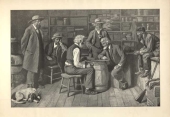The Checker Maven
The World's Most Widely Read Checkers and Draughts Publication
Bob Newell, Editor-in-Chief
Published every Saturday morning in Honolulu, Hawai`i
Noticing missing images? An explanation is here.
Migration
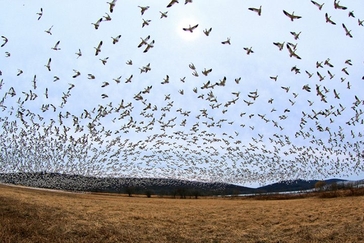
The Checker Maven has little in common with species who migrate often. But we are due for a different kind of migration.
Our website hosting company is moving us from an old server with old versions of software to a new server with new versions of software. Sounds good? Well, it turns out that our publishing platform, Nucleus CMS, needed a major update to even run at all on the new software.
It took us many hours of work, but we've prepared everything for the server move, and we'd like to hope it will go smoothly (famous last words). Now, the hosting company isn't able to tell us just when we'll get migrated over. We guess it's supposed to be some sort of surprise, which with computers is never a good thing.
We'll do our best to keep everything running as it should, but please help us out by telling us if you notice anything that doesn't work or doesn't look right, no matter how small. Please write to us at bugs@checkermaven.com. Mahalo for your support of The Checker Maven.![]()
Marvin at the Checker Academy

The turn of the scholastic year brought in a new freshman class at the elite National Checker Academy. Sponsored and operated by the National Checker League, the Academy put on a four-year accredited undergraduate program leading to the degree of Bachelor of Science in Checker Studies.
The curriculum was tough and demanding. Only the best could gain admission, and yet, despite major checker scholarships being offered by Big Ten universities, many a top high school player instead opted to brave the rigors of Academy study.
Tuition was free and the Academy provided room and board. Those who made it through the program--- and that certainly wasn't everyone, not by a long shot--- committed to five years of professional play, although many would go on to a lifetime career.

This year, the Academy invited Marvin J. Mavin to address the incoming class, and that invitation raised some eyebrows in the checker community. Usually the frosh were addressed by someone, well, a bit more on the academic side, someone more erudite and polished.
Of course Marvin was a star player, no doubt about it. But there were some who felt he didn't properly model the high academic and self-disciplinary standards that the Academy rigidly enforced.
Marvin, for his part, didn't really know what kind of a speech to give. So he figured he'd just sort of play it by ear.
Marvin was advised by Academy officials that there was a certain dress code observed at the Academy. All students wore suitable formal business attire at all times, which consisted of a white shirt or blouse, blue or brown tie, a conservative brown suit or pant suit, and brown wing-tip shoes or pumps.
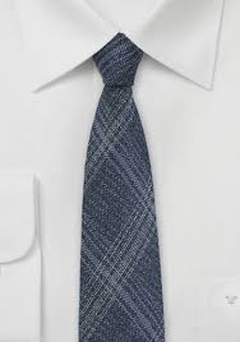
"I ain't wearing no tie," Marvin said at once. "You ain't gotta strangle yourself to play better checkers. You gotta breathe, man."
But his longtime girlfriend, business executive Priscilla Snelson, who was invited to be present with Marvin, put her foot down, and when she did, there was no opposing her.
So Marvin came to the lecture dressed in strict Academy attire, and after a brief introduction by the Dean of Freshman, Dr. Reginald Pastor, Marvin took the podium at the front of the Academy's ultramodern Tinsley Hall.

Marvin looked out over the audience. There were about a hundred members of the freshman class as well as many of the faculty, not to mention invited guests and a full compliment of newspaper, radio, and television reporters. And although Marvin didn't know it, his lecture would be live-streamed on the internet for a worldwide audience.
"Well, uh, hi there," Marvin began. "I'm like, you know, glad to be here. And stuff. Yeah."
Priscilla, from her front row seat, gave Marvin a cautioning look.
"Like, you know, you guys are good and all that..."

"We're not just guys," one young woman piped up from her seat in the back. "Women play professional checkers too!"
Marvin, a bit surprised, said, "Oh, sure, you bet. Real good too. I didn't mean ... well, anyhow. Like I said you guys--- and gals, okay?--- you're all good..."
"Why do you have to say 'guys and gals'?" the young lady in the back retorted. "Can't you just say 'checkerists' or 'people'? Why does this have to be a gender thing?"
Priscilla nodded approvingly but again Marvin didn't notice."
"Look here, I ... anyhow I wanted to start off with a really good problem and see how fast you guys--- people--- can solve it."
But by now nearly everyone in the freshman class had started to mutter. Even some of the faculty were shaking their heads.
"Okay, here's the problem," Marvin said. The following diagram was projected on the big screen at the back of the stage.
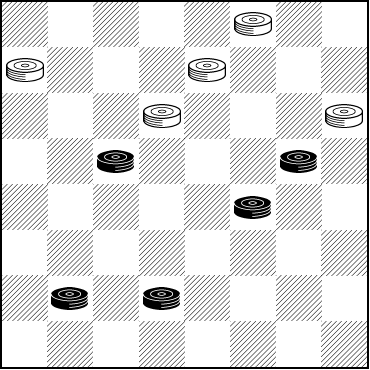
BLACK
Black to Play and Draw
B:W21,23,26,28,30:B7,8,14,17,19
"Okay there it is, fellas .... oops ..."
The muttering now turned into much more as catcalls rained out upon Marvin. Again, some of the faculty joined in. It was getting out of hand, and Dr. Pastor stepped up onto the stage, motioning Marvin away from the microphone.

"Mr. Mavin," Dr. Pastor began, addressing the crowd, "doesn't realize we respect and acknowledge all fifteen genders..."
Someone in the audience interrupted, "That's gender identities and there are sixteen, not fifteen!"
"Yes, excuse my error," Dr. Pastor replied. Thankfully the crowd was quieting down. "I'm sure Mr. Mavin won't repeat his errors. Isn't that right, Marvin?" Dr. Pastor concluded, looking directly at Marvn.
"Yeah, doc, didn't mean to make any of you boys angry."

That was it. The crowd erupted again and two uniformed security guards appeared on stage, quickly leading Marvin off, telling him it was for his own safety.
About half an hour later Priscilla met up with Marvin at the Security Office, when the security staff felt it was finally safe for him to leave.
On their way to the car Priscilla did little more than glare before finally saying, "I've warned you time and time again to be careful about disrespectful remarks."
"Disrespectful?" Marvin replied. "All I said was ..."
"Don't you dare repeat it!"
"But honey ..."
"Don't 'honey' me, either!"
"Okay, okay, I'm sorry. Can we go get a beer or something and kind of like make up?"
Priscilla shook her head in dismay.
"Like, maybe when we get to the airport?"

"Get in the car, Marvin. Sometimes, I wonder just what I see in you."
Marvin, at this point, knew it would be best to keep very quiet and do as he was told.
The students at the Checker Academy never did get to solve Marvin's problem. Can you? We guarantee that the solution is 100 percent gender free. See what you can do and then click on Read More to check your moves.![]()
Checker Jargon

It seems that an obsession with jargon has dominated the business world during the past few decades. There's "rightsizing," "synergy," "proactivity," and thousands more, and it seems that such terms offer very little other than a way to take up screen space in yet another stultifying PowerPoint presentation.
In today's Checker School entry, our friends Skittle and Nemo return. You'll recall that they are to be found in Andrew J. Banks' fascinating book, Checker Board Strategy. Let's listen in as Skittle instructs Nemo. Note that Skittle prefers the word "vocabulary" over "jargon."
"As we solve problems," Skittle suggested to Nemo, "let's use the checker vocabulary. When you jump two pieces, call it a 'Two-Shot.'"
"Why get technical?" protested Nemo. "Solutions flash on me. Checkers is the silent game."
This raises an interesting question: Just how much does 'checker jargon' such as "Two-Shot", "Breeches," and all the rest, add to our learning and understanding? We'd posit that when a name reinforces the idea concerned, it's useful. A "breeches" position is easy to picture and easy to remember. A "Two-Shot" is just as clear. But the names of openings, for instance, while providing a convenient shorthand, don't really tell us much in and of themselves.
Mr. Banks uses the following position as an illustration. Can you solve it--- and come up with some "checker jargon" to describe the solution?
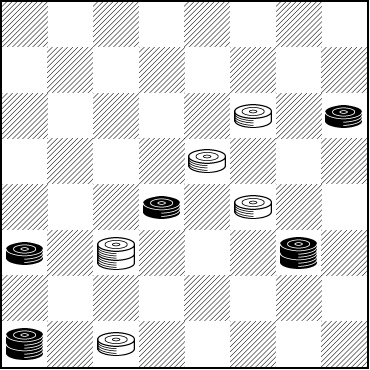
WHITE
White to Play and Win
W:W11,15,19,K22,30:B12,18,21,K24,K29
You won't be able to merely talk your way through this one, and we don't know if the solution will "flash" on you, but we won't insist that you solve it silently. Do however give it a try. It's not especially difficult. Flash your mouse on Read More when you're ready to see the solution.![]()
CV-2: Brian's Bridge

The bridge and trail above, near Martin, Tennessee, are named after Brian Brown. That's one example of "Brian's Bridge."
Today, for the second in our series of special Wednesday publications, we present problem CV-2, composed by Brian Hinkle, which is his own interpretation of "Brian's Bridge." Needless to say, it's a difficult problem--- something to keep you occupied during the present public health emergency--- and we'll give you two weeks to solve it before publishing both the solution and the next problem in our series (and let's hope this doesn't go on long enough to reach problem CV-19).
Here's the position.
BLACK
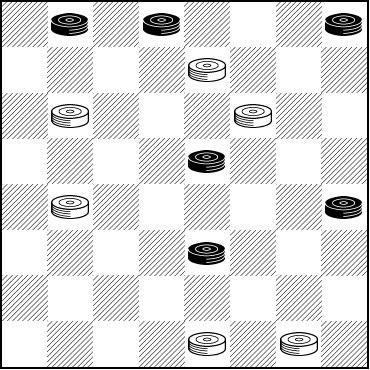
WHITE
White to Play and Win
W:W7,9,11,17,31,32:B1,2,4,15,20,23
It is our wish that this problem, along with our regular Saturday columns, will provide you some needed entertainment during difficult days. Stay safe and well, checker fans, wherever you are.![]()
CV-1 Solution
BLACK
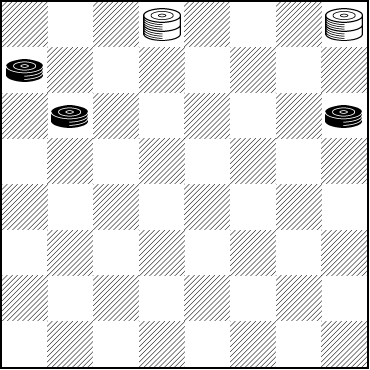
WHITE
White to Play and Draw
W:WK2,K4:B5,9,12
Brian Hinkle's 2x3 problem published two weeks ago, which we've called CV-1, is a deep and difficult setting. ACF Bulletin editor Jim Loy wrote to Brian saying that there are probably a thousand drawing possibilities and it would take a year to unravel. This is surely one of the best 2x3 problems ever published. There is no doubt that the draw is subtle, finely balanced, and relies on moves which at times don't seem intuitive or natural.
It's impossible for us to go into everything in a single column, so we'll just show a couple of options and let you use your computer to work through the many different variations.
When you're done, Brian would like to know what your favorite drawing line might be. Write to him at sbhinkle@charter.net with your comments.
Brian points out three major drawing themes: a line that ends in Payneís Double Corner Draw, one that ends in Rogerís Draw, and one that ends in Dr. Brownís Draw (as in Boland's Famous Positions page 19).
Brian elaborates: If Black keeps the man on 12, then Rogerís Draw is needed. If Black advances the man on 12 to 20, then Payneís Double Corner Draw is in order. Finally, the important transposition into Dr. Brownís Draw shows why White must start with 4-8* and 8-11*.
Wow!
First, we'll show Brian's chosen solution, the one he thinks best represents the trunk line. The solution is very long, and you may wish to use this animation. Notes were provided by Brian.
| 1. | ... | 4-8 |
Note that the seemingly "obvious" 2-6 (chasing with the king) will lose, as will 2-7.
| 2. | 12-16 | 8-11 |
| 3. | 16-19 | 11-15 |
| 4. | 19-23 | ... |
Or 19-24 15-10* 24-27 2-6 (chasing with the king is now correct) 9-13 10-14 27-31 6-10 31-27 10-15 27-23; this is the same draw as in Dr. Brown's Famous Positions, p.19, colors reversed.
| 4. | ... | 15-18 |
| 5. | 23-26 | 18-22 |
| 6. | 26-31 | 2-6 |
| 7. | 9-13 | 6-10 |
| 8. | 31-27 | 10-14 |
| 9. | 27-23 | 14-10 |
| 10. | 23-19 | 10-14 |
| 11. | 19-15 | 22-25 |
| 12. | 15-11 | 25-22 |
| 13. | 11-7 | 22-25 |
| 14. | 7-2 | 25-22 |
Stopping the Black king with 14-10? might be tempting but it loses by 15. 13-17 10-14 16. 17-21 25-22 17. 2-6 14-18 18. 6-9 18-23 19. 9-13 23-26 20. 5-9 26-23 21. 9-14 23-26 22. 14-17 22-18 23. 17-22 Black Wins.
| 15. | 2-6 | 14-18 |
| 16. | 6-9 | 18-23 |
| 17. | 9-14 | 23-26 |
| 18. | 14-17 | 22-18 |
| 19. | 17-21 | 18-22 |
| 20. | 21-17 | 22-18 |
| 21. | 5-9 | 26-23 |
| 22. | 17-14 | 18-22 |
| 23. | 14-10 | 23-18 |
White has to defend accurately; if 23-26? then 24. 10-15 26-23 25. 9-14 23-26 26. 14-18 22-25 27. 13-17 Black Wins.
| 24. | 10-7 | 22-25 |
| 25. | 7-11 | 25-22 |
| 26. | 11-16 | 22-25 |
| 27. | 16-20 | 25-22 |
| 28. | 20-24 | 22-25 |
| 29. | 24-27 | 25-22 |
| 30. | 27-31 | 22-25 |
| 31. | 31-26 | 25-30 |
| 32. | 26-31 | 30-25 |
| 33. | 31-27 | 25-22 |
| 34. | 27-24 | 22-25 |
| 35. | 24-19 | 25-22 |
| 36. | 19-16 | 22-25 |
| 37. | 16-11 | 25-22 |
| 38. | 11-7 | 22-25 |
| 39. | 7-2 | 25-22 |
| 40. | 2-6 | 22-25 |
| 41. | 6-1 | 25-22 |
| 42. | 1-5 | 18-23 |
| 43. | 9-14 | 23-26 |
| 44. | 5-1 | 26-23 |
Precision play is required: if 26-30? then 45. 1-6 30-26 46. 6-10 26-23 47. 10-15 23-26 48. 14-18 22-25 49. 13-17 Black Wins.
| 45. | 1-6 | 22-18 |
| 46. | 6-9 | 18-22 |
| 47. | 14-17 | 22-18 |
| 48. | 9-6 | 23-26 |
| 49. | 6-2 | 26-30 |
With the Black king way back on square 2, White must now force the Black piece on 17 into square 21. If 18-22? then 50. 2-7 22-18 51. 7-11 26-30 52. 17-21 18-22 53. 11-15 30-26 54. 15-19 26-30 55. 19-23 22-26 56. 23-18 26-31 57. 13-17 31-26 58. 18-14 26-31 59. 17-22 Black Wins.
| 50. | 2-7 | 30-25 |
| 51. | 17-21 | 25-22 |
| 52. | 7-11 | 18-23 |
| 53. | 11-16 | 23-27 |
| 54. | 16-19 | 27-32 |
| 55. | 19-23 | 32-28 |
| 56. | 23-27 | 28-32 |
| 57. | 27-31 | 32-28 |
| 58. | 31-27 | 28-32 |
| 59. | 27-24 | 32-28 |
| 60. | 24-19 | 28-32 |
| 61. | 19-15 | 32-27 |
| 62. | 15-10 | 27-23 |
| 63. | 10-14 | 23-26 |
| 64. | 14-10 | 26-23 |
Drawn. An example of "one holds two."
Next, we'll show a line that we took from the KingsRow engine, using its 10-piece endgame database. Brian called this one, "The King Goes on a Vacation." An animation can be found here.
| 1 | ... | 4-8 |
| 2. | 9-14 | 8-11 |
| 3. | 5-9 | 2-7 |
| 4. | 14-18 | 7-10 |
| 5. | 18-22 | 11-15 |
| 6. | 22-25 | 15-18 |
| 7. | 25-30 | 18-23 |
| 8. | 9-13 | 10-14 |
| 9. | 12-16 | 14-10 |
Brian comments, "This white king decides that now is a good time to 'go on vacation' because the other king on 23 is doing all of the heavy defensive lifting."
| 10. | 13-17 | 10-7 |
| 11. | 17-22 | 7-3 |
| 12. | 16-20 | 23-27 |
| 13. | 22-25 | 3-7 |
The computer here gave 22-26 which no human would likely play.
| 14. | 25-29 | 7-10 |
| 15. | 29-25 | 10-15 |
| 16. | 25-22 | 27-32 |
This has now transposed into the solution of Brian Hinkle's A Walk Through Time from Ed Salot's problem composing contest 39.
| 17. | 22-26 | ... |
20-24 is interesting, hoping for the blunder 32-28? Black Wins. But if White avoids the trap, 20-24 only draws.
| 17. | ... | 32-27 |
| 18. | 26-22 | 27-32 |
| 19. | 22-17 | ... |
The computer gives 22-26, leading to repetition, but this is another try.
| 19. | ... | 15-11! |
Not 15-18, which loses.
| 20. | 17-14 | ... |
The computer gives 17-22.
| 20. | ... | 11-15 |
| 21. | 30-26 | 32-27 |
| 22. | 14-9 | 15-10 |
| 23. | 26-22 | 10-15 |
| 24. | 9-14 | 15-19 |
| 25. | 14-18 | 19-24 |
| 26. | 18-15 | 24-28 |
| 27. | 15-19 | 28-32 |
| 28. | 22-18 | 32-28 |
| 29. | 19-23 | 28-32 |
| 30. | 23-19 | 32-28 |
Etc. Drawn. A double corner defense which will work as long as the remaining single Black man can't crown.
There is much, much more to this problem and indeed one could spend a year on it. We'll just copy the line seen in many an advanced math textbook: "The rest is left as an exercise for the reader."
Our thanks to Brian Hinkle for this problem, and to Brian and Jim Loy for much of the analysis.![]()
All Is Not Lost
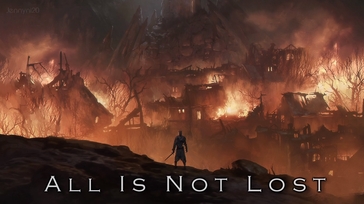
Some situations seem pretty hopeless. In the image above, things don't look so great for our hero. But you might guess that he's not one to easily give up.
The same is often true on the checkerboard. Take a look at the position below.
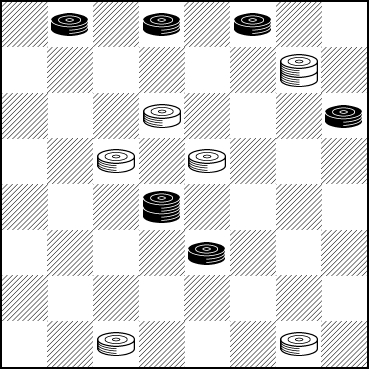
WHITE
White to Play and Win
W:WK8,10,14,15,30,32:B1,2,3,12,K18,23
White is going to lose a piece and nothing will stop that. But indeed all is not lost---there still is a way to win, if you don't give up hope and can find your way through. This isn't quite a speed problem, but it isn't all that difficult, either. Stay the course and win the battle, then click on Read More to verify your victory.
And stay safe and well, checker fans, wherever you are.![]()
A Snowy Day at the Beacon
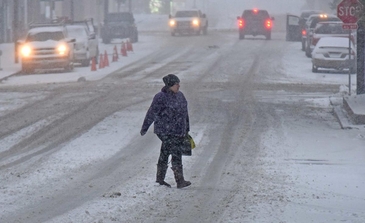
In Bismarck, North Dakota, the snow season starts around October and runs well through April. Some of the heaviest snowfalls can occur later in the season.
So, on a March Saturday in 1955, there was the feeling of snow in the air. It's familiar to anyone who lives in a northerly climate. You didn't need a weather forecast to know that it was going to start snowing later that day, and probably quite a lot.
But the threat of bad weather didn't stop Sal Westerman from walking over to the Beacon Cafe at 1 PM for the regular Saturday session of the Coffee and Cake Checker Club. There would be plenty of Deana's hot coffee and some freshly-baked treats. Deana ran the Beacon and her baked goods had no match for miles around.
Turnout was a little less than usual. Just three of the boys (who were all over 50) were there: Dan, Wayne, and Mike, who, like Sal, showed up just about every single week.
"Too bad the others aren't here," Sal said, "for I've got a nice one from Brian this week." Brian, in St. Louis, was one of Sal's checker pen pals.
"Maybe they were scared off," Wayne said. "Brian's problems can be pretty tough."
"Oh, it's just the weather," Sal said. "But I want to know what kind of treats you boys will be buying me when you can't win this one."

Deana, stationed behind her counter and ever alert, piped up, "Fresh pecan bars. Just the right thing to make you feel warm and comfy on a snowy day." She smiled, knowing she'd be selling quite a few servings before the afternoon was out.
"Well, there you go," Sal said. "I just love pecan bars. Might even let you buy me two."
Dan laughed. "We'll see about that," he said. "Now set 'em up and let's have a look."
The first few snowflakes were starting to fall outside as Sal set up the problem. But none of the boys noticed, as they were immediately engrossed in the following position.
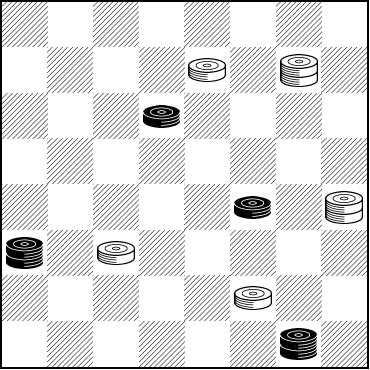
WHITE
White to Play and Win
W:W7,22,27,K8,K20:B10,19,K21,K32
Sometimes Sal only gave the boys five or ten minutes to solve a problem. But problems from Brian or Ed (Sal's Pennsylvania pen pal) were tougher, and although Sal liked to win, he was always fair about things.
After about an hour, Deana said, "It's snowing pretty hard now. Might have to close up early. I live over in Mandan and driving is going to be tough." Mandan was a smaller town just across the Missouri River from Bismarck.
But no one heard her. Concentration was too deep. And then, Dan spoke up. "It's kind of hard to find., but I've got it."
"Is that right?" Sal said. "Show me."
Is Dan about to win pecan bars for all of the boys? How would you do? Hopefully you're not in the middle of a snowstorm, and can give today's problem a good effort. Don't flake out or drift away; plow ahead and when you're ready, click on Read More to see the solution and the conclusion of our story.![]()
Checker Maven Special Edition

Many of us in the checker community are older and may have underlying health issues that put us at higher risk from the current virus epidemic, so we need to stay at home. Many others are under mandate to do the same. But no matter who we are or where we are, it's a good idea.
That gives us a lot of potentially unoccupied time. Correspondent Brian Hinkle suggested that this would be a good moment for checker fans to attempt deep and difficult checker problems.
Hence this special edition, in which we present one of Brian's own compositions, one which he considers to be challenging indeed. We won't be publishing the solution for two weeks in order to give you a chance to really dig into it.
Even if you're closer to novice than expert, this problem is worth your while. Maybe you'll solve it, maybe you won't, but you'll likely pass quite some time with good checker entertainment, and perhaps be distracted a little when you need it the most.
Here's the position, without further commentary. Good luck!
BLACK

WHITE
White to Play and Draw
W:WK2,K4:B5,9,12
Be safe and well, checker fans, wherever you are.![]()
50th Problem Composing Contest

Mr. Bill Salot
Today (March 21, 2020) marks the start of Bill Salot's 50th Unofficial World Championship Checker Problem Composing Contest, which can be found on the American Checker Federation website.
Mr. Salot has long been an inspiration to us (and is indirectly responsible for our decision to continue publishing The Checker Maven beyond our initial 15 year run). He has reached age 90 without skipping a beat or seeming to slow down in the slightest.
Mr. Salot's eight-year long series of competitions has brought us a wealth of modern checker problems of amazing depth and quality. Each contest is eagerly anticipated by solvers and composers alike. Mr. Salot was kind enough to grant us an interview on the occasion of this milestone 50th event.

What gave you the idea for these contests in the first place?
It developed over a long period of time.
During my teen age years, in the 1940s in Detroit, I learned that tournament play was hard work while composing problems was fun. The latter became my primary hobby.
By the 1960s, I was corresponding with great composers. We freely shared many original problems, and published our best in the checker journals of the day. Occasionally our problems appeared side-by-side, and I found myself comparing them to determine which impressed me most.
I passed on to my composer correspondents the idea of side-by-side competition, and they liked it. A series of contests was born. We composers agreed to my publishing small groups of our confidential, original, unpublished problems along with requests for readers to rank the problems and mail me the results for publication.
Most , if not all, of the judges in a given contest ended up being the composers who did not happen to have a problem in that contest. They rotated between competing and judging. They included Ben Boland, Tom Wiswell, Joe Charles, Saul Cass, Milton Johnson, Floyd Brown, a young Melvyn Green, and others.
There were more than 30 such contests in the late 1960s and early 1970s. You can find them recorded in the ACF Bulletin and Elam's Checker Board, a few in the English Draughts Journal and a New Zealand publication.
The contests died out partly because of composer burnout and partly as a result of my parents' illnesses, together with a change in my responsibilities at work. I then dropped out of checkers for more than 35 years.
I woke up when a friend told me that nowadays chess and checkers are played on the internet. He gave me a couple of web sites. On the front page of the ACF site, previously published problems were periodically displayed. I thought, what a fine place that would be for a composer to display original, unpublished problems!

Later somebody posted, on the ACF Forum, a survey question complete with means to cast electronic votes. I saw that would be a great tool for reviving problem composing contests. Eventually Jason Solan set up a contest page and taught me how to administer it. The first contest then took place in January 2012.
How would you describe or characterize the way the contests have been received by the checker community? What sort of feedback have you gotten?
The number of returning visitors to and participants in each contest probably rivals the number of visitors and participants in most checker forums. In my infrequent ventures into tournaments, I get unsolicited positive comments and encouragement, never anything negative. The same is true for voting correspondents. So I would say the contests are generally well received by the checker community.
But composers tend to be more critical. They dislike problems that may be similar to published play, or seem undeserving of the votes they received, or are too unnatural in appearance, or too simple, or too laborious. Composers are sometimes sensitive to how problems are selected, or how solutions are presented, or how slow the contests are, or how few participate. I think all these criticisms are constructive, and the contests have improved as a result of them. I believe competing composers are generally loyal, have compositions to spare, want to win, and when they persist, eventually do win, while generally accepting losses along the way.

What do you see for the future of these contests? Do you plan to continue them indefinitely?
Yes, certainly continue them indefinitely! The backlog of original, unpublished problems has not run out. The contests should have some time left. After all, I am only 90. But eventually they will cease, unless and until somebody else wants to give them a try. So far there have been no applicants.
Problem composition is a true art. Have you seen this art develop over the course of the first 49 contests? How would you characterize today's problems compared with past history?
Problemists feel like artists, even when not recognized as such. But isnít that true of any avocation? Yes, the quality of the contests themselves have continuously improved, thanks to preliminary reviews, private discussions, computer-driven enhancements, and old-fashioned competitiveness. I canít emphasize enough the powerful influence of computers on todayís problems. They not only catch unsound analysis, they spring incredible surprises that seed new problems, many of which should be at least partially credited to the computer. The computer is the difference between historyís unsurpassed gems and masterpieces versus todayís new twists that would not exist without the computer. The computer is to problem composing what fracking is to natural gas production.

Any further thoughts or comments? Any stats you'd like to share?
Statistics are a boring waste of time unless they tell you something you didn't know before. Many stats on past problem contests (2012 - 2019) are posted at the web site. They are also in the annual Year in Review" articles on the ACF Forum.
Let me mention a few things that the contest statistics have taught me, or I should say humbled me.
1. One well-known player warned that the problem composing contests would not get off the ground, if previously published and flawed problems were not screened out beforehand by reviewers with huge databases. He was right. The first year, 7 of 30 problems entered (>23%) were disqualified, including the winners of 2 contests. A call went out for willing reviewers with large databases. A team was formed that is still intact. Only one problem was disqualified in 2013, one in 2014, one in 2016, one in 2017, and two in 2018. So 6 of 191 problems entered after 2012 (<3.2%) were disqualified. Thatís not perfect, but not bad.
2. Another well-known player recommended that the contests not include problems that were 4x4 or smaller. He warned that almost all ideas possible in positions that small have already been published. He apparently was mistaken. Of the 215 problems not disqualified in Contests 1 through 48, 66 (>30%) were 4x4 or smaller. Contest 10 was devoted entirely to 4x4s; Contests 40 and 50 have only 3x3s. Such problems apparently are not exhausted.
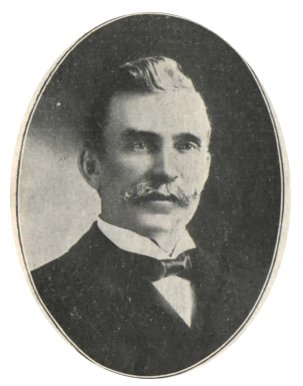
George H. Slocum
3. These contests included perhaps the rarest of all human competitions, the living versus the dead. Six times, living problemists were challenged by George H. Slocum, who died in 1914. Slocum is acknowledged as one of the greatest checker problem composers of all time. Jim Loy found a bunch of Slocum problems published in an obscure journal, unknown to our generation because they were never republished elsewhere. We entered six of them in contests, during 2016-2017, to see how they would fare against todayís talent. They all lost, which only means they probably were not among Slocumís best efforts. After the votes were counted, each of the six Slocum problems was disqualified due to their prior publication. These problems and disqualifications were not counted in item 1 above.
4. The three contests with the most votes by far were contests 2 (35 votes) and 3 (40 votes). They made us think that the contests had exploded in popularity. But that didnít make any sense. Those early contests had no publicity outside of the web site, and they did not run for six weeks as they do now. It turned out that a strange glitch in the voting program was resetting the voting button, implying that a vote was not accepted and needed to be cast again. The Web Master was unable to eliminate the glitch, but he did add an ďI already votedĒ button, which persuaded voters to not vote multiple times. After that, the voting settled into a normal average of 17 per contest.
5. After years of problem composing experience and correspondence with many great composers of yesteryear, I truly expected to dominate these contests at the outset. That was before I heard of the likes of Roy Little, who subsequently won or tied for first 19 times and won Problemist of the Year 4 times, and Ed Atkinson, who won or tied for first 14 times and won Problemist of the Year 3 times. They did it all without entering every contest. I am the only one who did. In contests that Roy and Ed entered, Jim Loy and I each won or tied for first only 7 times. Leo Springer did it 5 times in 5 tries. The sum of all those wins exceeds the number of contests because of the many ties. I am especially humbled by my 6 entries that received zero votes each.
6. I believe some of the clearest indications of the contest voting statistics apply to other aspects of human life, such as politics, religion, ethics, morals, etc. Different people simply look at the same problem and see something entirely different. They often, not just sometimes, draw diametrically opposite conclusions. In 32 of the first 48 contests, every problem received at least one vote for first place. In other words, two-thirds of the time, every problem, even the worst one, is voted best by somebody. If we cannot agree on the value of something as minor as a position on a checkerboard, is it any wonder that we canít consistently agree on real world issues?
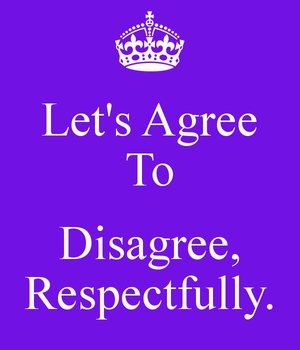
The Checker Maven once again thanks Mr. Salot for his time in providing answers to our questions, and for the opportunity to give our readers an insight into his monumental, ongoing contributions to the game. Now, as a special treat (and it's special even if you've seen it before), here is a unique problem by Bill Salot, which he originally called Don't Ask--- as in, "don't ask" how the position arose!
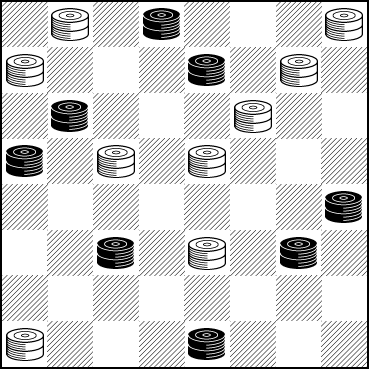
WHITE
White to Play and Win
W:WK1,K4,K5,K8,K11,K14,K15,K23,K29:BK2,K7,K9,K13,K20,K22,K24,K31
This one is really something, and we're certain you'll enjoy solving it. But if you're not able to contest it, clicking on Read More will uncontestedly show you the solution.![]()
Fatal Squeeze

This woman is either brave and skilled, or courting disaster, risking a fatal squeeze from a huge, powerful snake.
Today in our Checker School series, we return to the adventures of Skittle and Nemo, as found in Andrew Banks' Checker Board Strategy. The title of our column is a big hint for the solution to the problem below, so we're not giving much more away when we note that Skittle warned Nemo, "Always look well before you squeeze a piece."
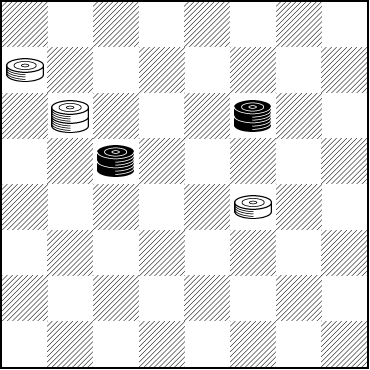
BLACK
Black to Play and Win
B:W14,K24,28:BK19,K22
White has just blundered badly by playing 27-24. (White really should have won, so for extra credit, give a better move for White.)
This one is super easy and probably will be solved at once by players of any level above novice. (We like to have a balance in our columns; we don't want to squeeze anyone out by just publishing difficult positions.) When you've found the solution, check your work by squeezing the mouse button with the cursor on Read More.![]()
The Checker Maven is produced at editorial offices in Honolulu, Hawai`i, as a completely non-commercial public service from which no income is obtained or sought. Original material is Copyright © 2004-2025 Avi Gobbler Publishing. Other material is public domain, AI generated, as attributed, or licensed under CC1, CC2,CC3 or CC4. Information presented on this site is offered as-is, at no cost, and bears no express or implied warranty as to accuracy or usability. You agree that you use such information entirely at your own risk. No liabilities of any kind under any legal theory whatsoever are accepted. The Checker Maven is dedicated to the memory of Mr. Bob Newell, Sr.

